One of the unique dual AMD EPYC 7000 series servers we have seen is the Supermicro AS-4023S-TRT. This “A+ Server” as Supermicro would call it, is a 4U tower design. That means that the same form factor can be used as a pedestal server for branch office deployment. It also means that the same server can be deployed into standard racks. If you are building an appliance, this is very attractive. Also, given its size, it is able to handle a multitude of expansion cards and hot swap bay options.
Supermicro AS-4023S-TRT Test Configuration
Supermicro sent us the base unit for review, and we outfitted it with a few different configurations.
- Server: Supermicro AS-4023S-TRT
- CPUs: 2x AMD EPYC 7601, 2x AMD EPYC 7401, 2x AMD EPYC 7301, 2x AMD EPYC 7251
- RAM: 256GB in 16x 16GB DDR4-2666MHz RDIMMs
- SATA III Storage: 2x Intel DC S3710 400GB
- NVMe Storage: 1x Intel DC P3700 800GB AIC
- OS Storage: 2x 32GB SATADOMs
- Networking: Mellanox ConnectX-3 Pro EN dual-port 40GbE
We decided to utilize pairs of 32, 24, 16 and 8 core CPUs in the system to span the range. This is to give potential buyers a solid range of the different types of CPU options available. We also wanted to validate that this server can handle a full range of AMD EPYC 7000 series CPUs. We are also using our lab standard Mellanox ConnectX-3 Pro EN cards. We already have the 25/50/100GbE network running in our lab so this is something you can expect to see changes with over time. Still, 40GbE is extremely affordable and is a reasonably speedy networking connection.
Supermicro AS-4023S-TRT Hardware Overview
The Supermicro AS-4023S-TRT is a 4U machine that can handle two orientations. One is in a tower configuration with feet to provide stability. This is commonly used in branch office scenarios where there are no racks available. One can also remove the covers and use standard Supermicro rackmount rails to utilize the system in a standard rack.
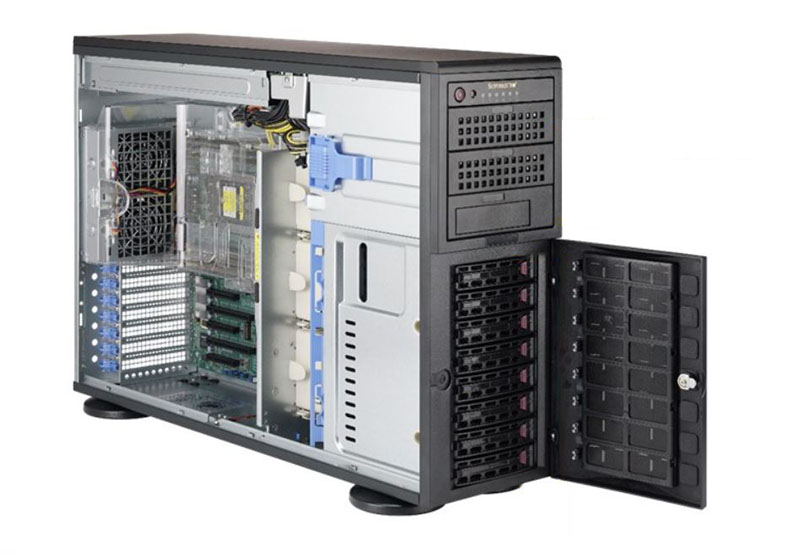
The system has 8x 3.5″ hot-swap bays. These hot-swap bays utilize a different tray than standard Supermicro rackmount servers instead opting for metal construction. Beyond these eight bays, there are also three 5.25″ bays for optical drives or using additional hot-swap bays. Those can be used to add 2.5″ U.2 or SATA/ SAS expansion.
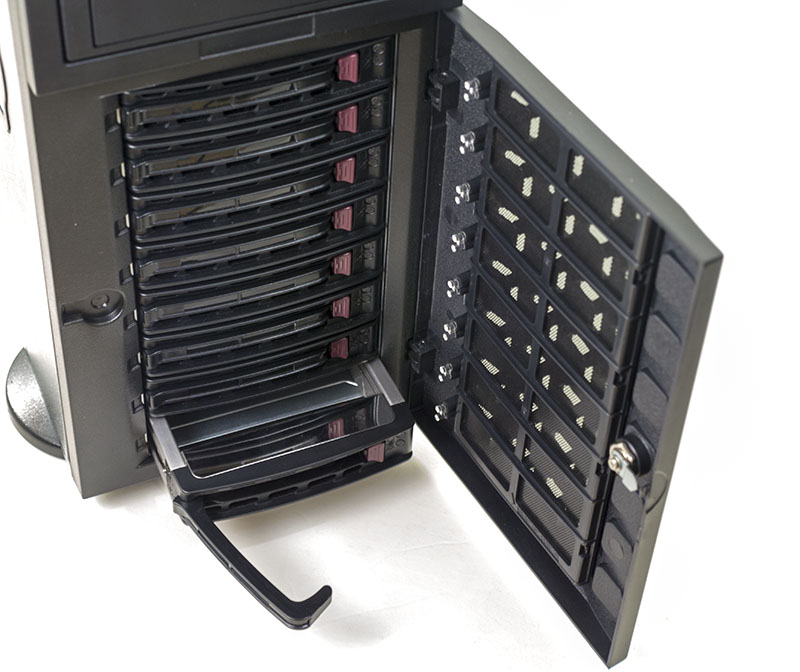
Power is provided via redundant 1280W 80Plus Platinum-level PSUs which provides both power efficiency as well as redundancy.
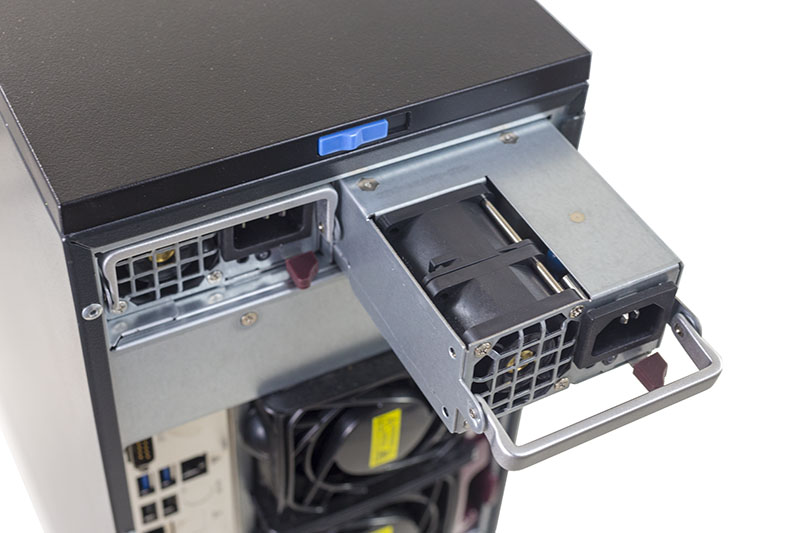
Just above the power supplies, you can see the blue latch which allows you to remove the top cover and install rails for rack mounting.
Along with hot-swapping power supplies, the fans in the chassis are all hot-swappable. This includes the midplane fans pictured above. The rear fans that exhaust air from the CPU cooling baffle can be hot-swapped without needing to open the chassis. This extends the field serviceability of the SUpermicro AS-4023S-TRT significantly.
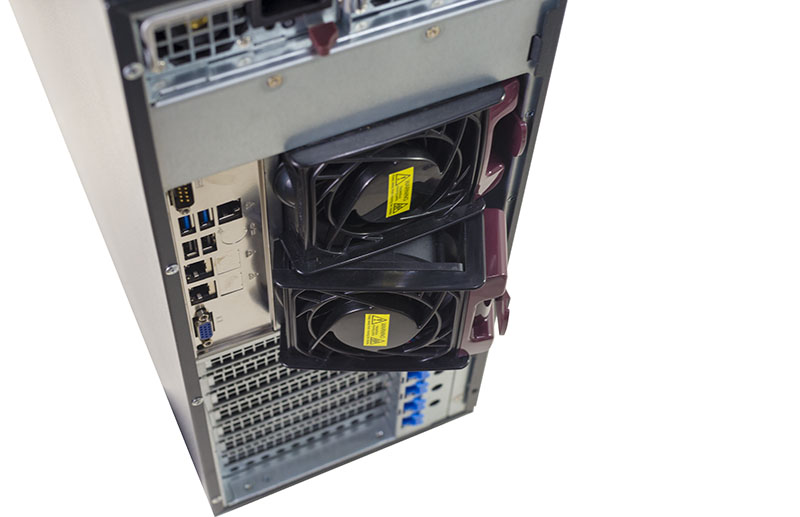
Internally, the Supermicro AS-4023S-TRT utilizes the Supermicro H11DSi-NT motherboard. You can read our Supermicro H11DSi-NT review for more in-depth review of that platform. We still wanted to cover how it is used in this server.
Each CPU is flanked by 8 DIMM slots for a total of 16 DIMMs in the Supermicro AS-4023S-TRT server. That configuration allows 1TB of DDR4 RDIMMs per CPU running at DDR4-2666 and up to 2TB for the entire motherboard. That is more RAM capacity per socket than current Intel Xeon Scalable CPUs can support unless you turn to their 1.5TB/ socket “M” SKUs which cost about $3000 more than the non-M counterparts. If you need 1TB of RAM per socket, this is essentially a $6000+ benefit from going with EPYC.
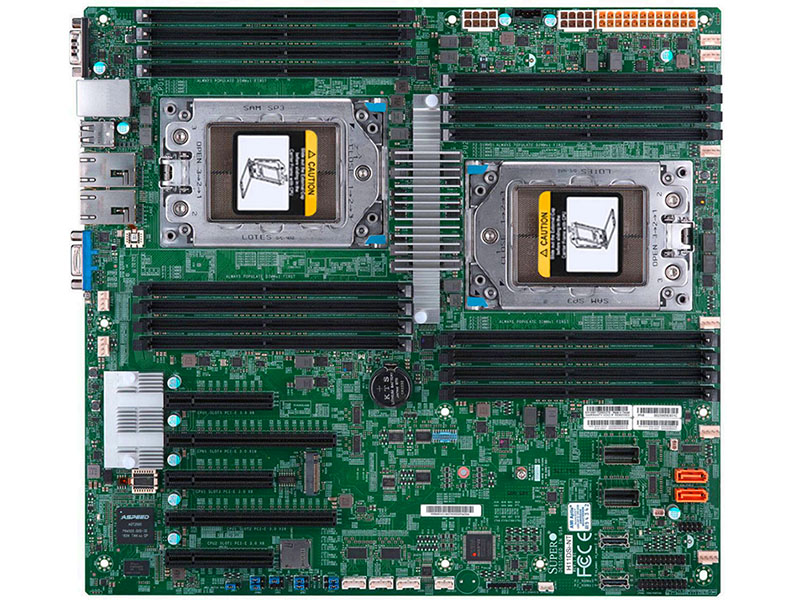
For storage, the Supermicro H11DSi-NT has an intriguing combination. There are 10x SATA III 6.0gbps ports, two of which are gold connectors able to provide SATADOM power without a cable. The other eight are provided via two SFF-8087 connectors which makes cabling to backplanes easy. In the Supermicro AS-4023S-TRT, these two SFF-8087 ports are used to cable the 8x 3.5″ SATA III hot-swap bays in the front of the chassis.
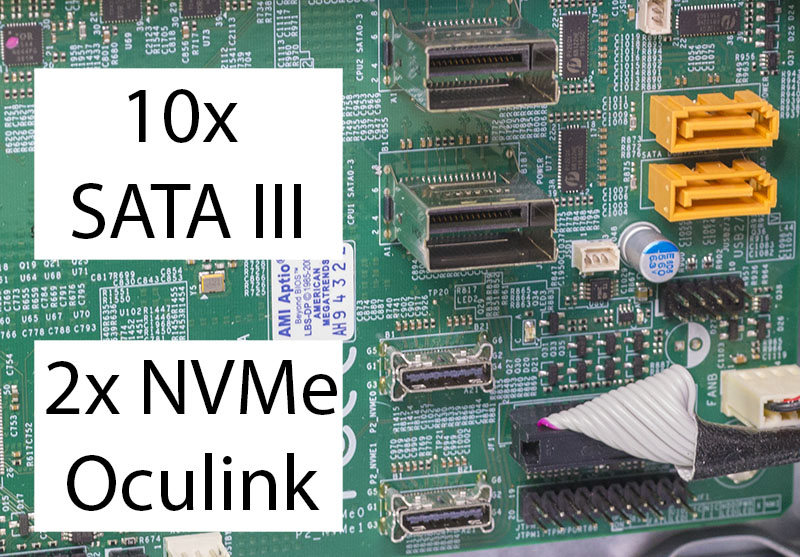
For NVMe storage, there is a pair of Oculink headers as well as a PCIe 3.0 x2 m.2 slot. We would have liked to have seen a PCIe 3.0 x4 m.2 slot, given the platform’s plethora of high-speed I/O but if you are using a drive such as the Intel Optane 800p, this is all that you need. We wished that the Supermicro AS-4023S-TRT included a dual 2.5″ NVMe front storage option to take advantage of the Oculink capabilities in this platform.
Add-in card expansion is provided via two PCIe 3.0 x16 and three PCIe 3.0 x8 slots. In the chassis there are several GPU power cables. Given space limitations, this means you can use about two PCIe x16 double-width cooler GPUs in the server. The top PCIe 3.0 x8 slot is open-ended but most GPUs will not clear the DDR4 DIMM slots behind it.
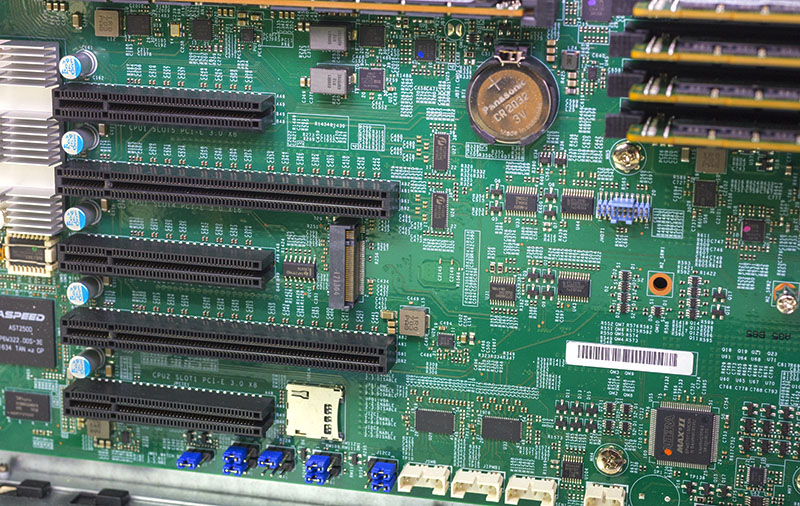
For the rear I/O there is an array of functional and legacy ports such as the two USB 2.0, two USB 3.0, VGA and serial ports. These help with connecting KVM carts in the data center should that ever be required.

The standout on the Supermicro H11DSi-NT is the dual 10Gbase-T networking. These use a modern Intel X550 10Gbase-T controller and aligns well with Supermicro’s Intel offerings. Standardizing on a NIC means that ISVs and VARs do not have to manage different NICs on Intel and AMD platforms.
Beyond these NICs, the server has plenty of expansion options for higher-speed NICs via PCIe expansion slots. In branch office deployments along with many data centers, RJ-45 networking is still used extensively so the 10Gbase-T as a starting case will fulfill many needs. For optical networking, add-in cards are the solution.
Next, we are going to discuss the management features of the Supermicro AS-4023S-TRT.

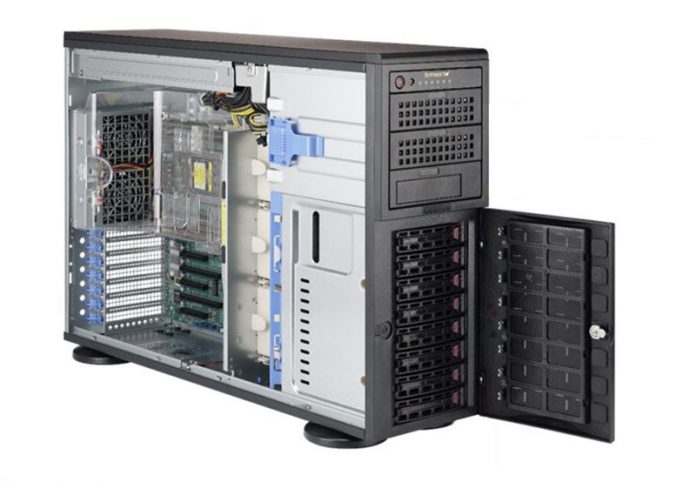



Great review STH. Really in-depth. This looks like a great machine but I wish it had the extra NVMe hot swap like you mentioned and support for 3 GPUs. I don’t really think 10g networking is getting adopted much in the DC but in offices I’m seeing it more often these days because you don’t have to redo wiring
Two AMD EPYC cpus can support 4 TB of RAM, which is incredibly powerful and unique, what happen to that. Is this system limited to only 2 TB of RAM.. even though it has a dual socket/cpu configuration..?
Only 8 dimms per cpu so this only supports 1TB per CPU not 2TB as if it had 16 dimms per cpu.
Hey! Nice review! Small typo:
Power is provided via redundant 1280W 80Plus Platinum-level CPUs which provides both power efficiency as well as redundancy.
I don’t think the CPU’s are powered by CPU’s ;)
Thanks @ Brennen Smith. Fixed.
Key Features
• Cloud Computing
• Data Center
• General purpose, SMB, Web Hosting
They forgot Gaming Desktop.
Churchill they also forgot NAS and router. SM’s version of every box is good for everything let’s pile on.
Interesting fact is that dual 7301 is at least in linux compile benchmark on the level of recently tested/reviewed X11SDV with D-2183. So man really need to decide if he needs 2 TB of RAM and if not, then they are smaller less noisy alternatives. Also it looks like for this box putting there 7301 is not the best option and if man sattles on dual CPU box, then the CPUs employed should be power-full enough not to be over played by single-CPU alternatives…
I wish it had storage options like Dell Poweredge T640. Even 1U/2Us have more storage these days.